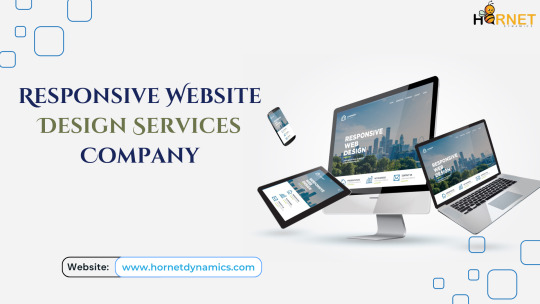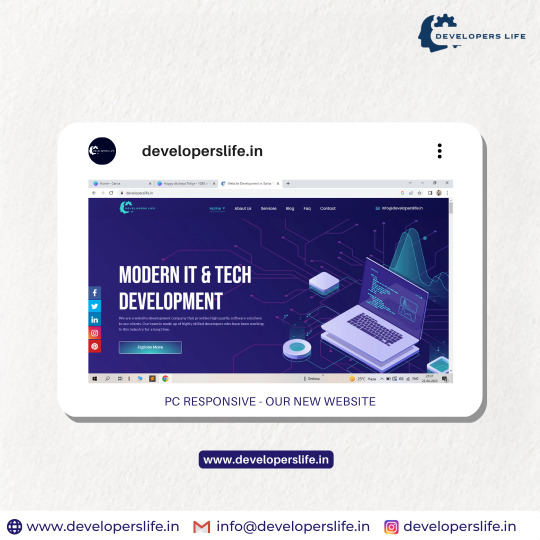#ResponsiveWebsiteDesign
Text
Creative Website Development Services by Skymattix
Transform your online presence with Skymattix's thorough Website Development Services. Our group of gifted designers makes responsive, easy to use websites that mirror your image's identity and draw in guests. Whether you want another website or a redesign, Skymattix provides customized arrangements that upgrade usefulness and stylish allure, driving more traffic and changes for your business.
#Canada#Toronto#Ontario#skymattix#WebsiteDevelopmentServices#Responsivewebsitedesign#WebsiteDesignServices
0 notes
Text
Responsive Website Design Services Company
We understand the importance of a website that provides exceptional user experience on devices with different screen sizes. Where mobile is the primary device. As a result, we provide responsive website design services that are customized to match a company’s specific needs.

#responsivewebsitedesignservices#responsivewebsitedesign#MobileAppUIUXDesign#ResponsiveWebsiteDesignServicesCompany#ServicesCompany#ResponsiveB2BWebsiteDesign#ResponsiveB2CWebsiteDesign#ResponsiveEcommerceDesign#WebsiteredesignservicesIndia#Bestresponsivewebsitedesignservices
0 notes
Text
Mobile Responsive Website Development India
A Responsive web design is nothing but a feature where your website content is capable of being compatible with all kinds of devices. Let it be desktop, laptop, tablet, or phone, when your website design is structured to be responsive, your site is supported in any kind of application.
Get your business online with us
Call & WhatsApp at +91 96673 57394
#WebsiteDesign#websitedesign#websitebuilder#websitedesigner#WebDevelopment#SoftwareDevelopment#MobileResponsiveDesign#DigitalMarketingServices#WebDesignCompanyIndia#WebDesignIndia#udaipur#India#responsivewebdesign#ResponsiveWebsiteDesign#responsivewebsites#responsivewebsite
0 notes
Text
Advantages of Responsive Ecommerce Website
Unlock the potential of your online store with a responsive website! Seamlessly adapt to any device, providing a smooth shopping experience for customers on the go. Reach more users, boost sales, and enhance user satisfaction.
Read More:- https://bit.ly/3PlRz1w
#ecommercewebsite#responsivewebsite#mobilefriendly#responsivedesign#ecommercedevelopment#responsivewebsitedesign#websitedevelopment#websitedesign#websitedesigning#websitedevelopmentcompany#worldwebtechnology
0 notes
Link
#affordablewebdesign#BestWebsiteDesignCompanies#CorporateWebsiteDesign#creativewebdesign#customwebsitedesign#e-commercewebsitedesign#freelancewebdesigner#FriendlyWebsiteDesign#GraphicDesignandWebDevelopment#Mobile-FriendlyWebDesign#ModernWebsiteDesign#ProfessionalWebsiteDesign#professionalwebsitedevelopment#ResponsiveWebsiteDesign#SEO#SmallBusinessWebsiteDesign#User-FriendlyWebDesign#WebDesignServices#webhosting#WebsiteDesignersNearMe#WebsiteRedesignServices#WordPressWebDesign
0 notes
Text

Are you looking for web design or development services in the UK?
If you are looking to revamp or design your website from scratch and need a developer to help you then look no further. Our development team has over a decade worth of experience building websites using all kinds of technologies and platforms.
We can help guide and will put together in place the best resources and plan to ensure that your website will be delivered on time and within budget.
Check out our Portfolio below for examples of our outstanding work.
Our Portfolio - SiliconTechnix
https://silicontechnix.co.uk/our-portfolio/
#SiliconTechnix#Responsivewebsitedesign#websitedesigncompany#websitedesignlondon#websitedesignerslondon#ecommercewebsitedesignlondon#websitedesign#cmswebdesign#webdevelopment#dentalwebsite#dentalmarketing#onlinepresence
0 notes
Text
Responsive Web Design: Key Elements And Examples
A functional website is crucial to the success of any modern business – the finest technique to get your message out to more people. Mobile phone usage has surpassed desktop computer use among users and customers, making a mobile-friendly website a must.
Web designers and developers are soon reaching a point where they can no longer keep up separate coding for new resolutions and devices. It would be impossible, or at least complicated, for many websites to develop a different version of their site for each solution and new device. Should we accept the inevitable drop in traffic from one device in exchange for an increase in traffic from another? Or is there anything else we can do?
Having a Responsive Design
For this reason, we now have a responsive design. By analyzing the width of the user’s browser or screen, responsive web design may easily reorganize and reformat the site’s information and pictures. A responsive website will work properly on any device, regardless of the screen size. Websites built with responsive design consider several screen sizes, including those used by desktop computers, laptops, smartphones, and tablets.

The majority (94%) of complaints about websites may be traced back to design issues.
There’s no denying that responsive web design is a significant talking point in the industry. The expanding variety of devices and browsers website visitors use justifies the notion of responsive web design. Our online designs now must work across various platforms, including desktop computers, laptops, iPads, iPhones, Android mobile devices, and netbooks.
In terms of market size, the global responsive web design market was valued at USD 11.57 billion in 2020 and is projected to reach USD 29.49 billion by 2026, growing at a CAGR of 16.4% during the forecast period 2021-2026, according to Mordor Intelligence.
First coined by Ethan Marcotte, the term “responsive web design” has been a hot trend in the tech world for a few years. The concept of “responsive web design” has been a critical player in the tech industry for several years. With a growing number of mobile device users and Google considers a website’s mobile-friendliness as a ranking factor.
What Is Responsive Web Design?
The term “Responsive Web Design” refers to a technique for creating websites that adapt to the viewing device’s width. Developers create a fluid layout that adapts dynamically to the width of the browser rather than a separate mobile version.
The concept of responsive web design refers to a method that proposes design and development that should react to the actions and surroundings of users depending on the screen size, platform, and orientation of their devices.
A combination of flexible grids and layouts, graphics, and judicious use of CSS media queries make up the practice. The user should be able to switch between their laptop and iPad. The website should adjust automatically to adapt to differences in resolution, picture size, and scripting capabilities.
Suppose the user has a virtual private network (VPN) for iOS installed on their iPad, for instance. In that case, the website should not prevent the user’s access to the page. This is one of the things that one may have to take into consideration. Put another way, and the website should have the technology necessary to adapt automatically to the user’s choices. Because of this, there wouldn’t be a need for a distinct design and development process for every new piece of technology that hit the market.
As a result, it is no longer a choice but rather a need for web developers and owners to construct flexible websites to deliver a better experience for their target audience. And as a consequence, see a rise in the number of visitors, produce leads, and get a better ranking on Google.
A responsive design responds to different sizes, orientations, and types of devices. With a responsive web design, website developers and designers aim to offer visitors a delightful user experience, irrespective of their device.
This article will discuss why you need a responsive website along with its benefits, comparison with adaptive design and critical responsive web design elements for all website owners.
Read here in details: Responsive Web Design: Key Elements And Examples
#responsivewebdesign#SolGuruz#Responsivewebdesignexamples#responsivewebdesignkeyelements#responsivewebsitedesign
0 notes
Text

!!! 𝐍𝐀𝐕𝐑𝐀𝐓𝐑𝐈 𝐎𝐅𝐅𝐄𝐑 !!!
𝐄𝐧𝐡𝐚𝐧𝐜𝐞 𝐘𝐨𝐮𝐫 𝐁𝐮𝐬𝐢𝐧𝐞𝐬𝐬 𝐖𝐞𝐛𝐬𝐢𝐭𝐞 𝐭𝐡𝐢𝐬 𝐍𝐚𝐯𝐫𝐚𝐭𝐫𝐢. 𝐄𝐧𝐣𝐨𝐲 𝐔𝐩 𝐭𝐨 𝟐𝟎% 𝐃𝐢𝐬𝐜𝐨𝐮𝐧𝐭 𝐨𝐧 𝐎𝐮𝐫 𝐖𝐞𝐛 𝐃𝐞𝐯𝐞𝐥𝐨𝐩𝐦𝐞𝐧𝐭 𝐒𝐞𝐫𝐯𝐢𝐜𝐞𝐬. 𝐂𝐚𝐥𝐥 𝟕𝟗𝟎𝟔𝟒𝟓𝟓𝟕𝟔𝟎 𝐍𝐨𝐰!
Visit - www.monteage.in
#!!! 𝐍𝐀𝐕𝐑𝐀𝐓𝐑𝐈 𝐎𝐅𝐅𝐄𝐑 !!!#𝐄𝐧𝐡𝐚𝐧𝐜𝐞 𝐘𝐨𝐮𝐫 𝐁𝐮𝐬𝐢𝐧𝐞𝐬𝐬 𝐖𝐞𝐛𝐬𝐢𝐭𝐞 𝐭𝐡𝐢𝐬 𝐍𝐚𝐯𝐫𝐚𝐭𝐫𝐢. 𝐄𝐧𝐣𝐨𝐲 𝐔𝐩 𝐭𝐨 𝟐𝟎% 𝐃𝐢𝐬𝐜𝐨𝐮𝐧𝐭 𝐨𝐧#Monteage#navratrioffer#FestiveDeals#webdevelopmentservices#digitalsolutions#websitedesign#onlinemarketing#ecommercedevelopment#ResponsiveWebsiteDesign#customwebdesign
0 notes
Text
Master the Art of Responsive Design for Website Success
Having a mobile-friendly website has become non-negotiable in today's digital age. With over 3 billion smartphone users worldwide, mobile devices account for a significant portion of internet traffic. Responsive design ensures that your website is optimized for different screen sizes and device types, providing a seamless user experience.
Adaptive web design is another crucial aspect of responsive design, enabling websites to adapt to the individual needs and preferences of users. Responsive web development involves implementing various elements such as responsive layout, responsive design framework, and responsive design templates to create a visually appealing and user-friendly interface.
Partnering with a responsive web design agency or using a responsive website builder can simplify the process and provide tailored solutions to meet your business needs.
Key Takeaways
- Responsive design is crucial for achieving website success in today’s mobile-first world.
- Adaptive web design enhances user experience by tailoring your website to individual needs and preferences.
- Responsive web development involves various elements such as a responsive layout, responsive design framework, and responsive design templates to create an optimal user experience.
- A responsive web design agency or website builder can simplify the process and provide tailored solutions.
Understanding Responsive Design: A User-Centric Approach
Responsive design is all about creating a seamless user experience, regardless of the device or screen size. A user-centric approach puts the user at the center of the design process, ensuring that your website is optimized for their needs.
Mobile optimization is a crucial component of responsive design, as more and more users access websites on their smartphones. With responsive design, your website will adapt to different screen sizes and orientations, providing a consistent and user-friendly experience for all visitors.
By implementing a user-centric approach to responsive design, you can improve engagement and conversions, and enhance the overall usability of your website. So, whether your users are browsing on a desktop computer or a mobile device, they'll have a seamless experience with your brand.
The Benefits of Responsive Design
Responsive design offers numerous benefits for your website, ranging from improved user experience to increased search engine rankings and site performance.
Improved User Experience
Responsive design ensures that your website adapts seamlessly to different screen sizes and devices, providing a consistent and user-friendly experience. Whether your audience is accessing your website from a desktop computer or a smartphone, they will be able to navigate easily and access information quickly.
Increased Search Engine Rankings
Search engines such as Google prioritize websites with responsive design, as they provide a better user experience. This can lead to increased visibility and a higher ranking on search engine results pages, ultimately boosting your website traffic and conversions.
Optimized Site Performance
Responsive design involves optimizing your website's performance across different devices, resulting in faster load times and a smoother browsing experience. This can lead to reduced bounce rates and increased engagement from your audience.
By implementing responsive design on your website, you can unlock these benefits and achieve website success. Prioritizing user experience, search engine rankings, and site performance can have a significant impact on your online presence and overall business success.
Responsive Design Best Practices
When it comes to implementing responsive design, there are certain best practices to keep in mind. These practices can help ensure that your website functions seamlessly across different devices and screen sizes, providing an optimal user experience.
Accessible Content
Firstly, it's essential to create accessible content that can be easily consumed on a range of devices. This means using fonts that are legible on smaller screens, keeping line lengths reasonable and avoiding large blocks of text.
Flexible Images
Images are an integral part of any website, but they can pose challenges when it comes to responsive design. One solution is to use flexible images that can adapt to different screen sizes. This can be achieved through the use of responsive images, which are loaded dynamically based on the device's screen size.
Breakpoints
Breakpoints are an essential component of responsive design. They define at what point the design should change to accommodate different screen sizes. It's crucial to set breakpoints based on common device sizes to ensure that your design functions correctly.
Load Time Optimization
Finally, load time optimization can significantly impact the user experience on your website. Since responsive designs often involve loading additional assets, it's crucial to optimize load times. This can be achieved through techniques such as compressing images, minifying code, and reducing server response times.
By following these best practices, you can ensure that your responsive website design functions flawlessly across various devices, providing an optimal user experience and boosting your website's success.
Choosing the Right Responsive Design Framework
When it comes to selecting the appropriate responsive design framework for your website, there are various factors to consider. By choosing the right responsive design framework, you can streamline your design process and achieve optimal results. Here are some key considerations:
Customization Options
Make sure that the responsive design framework you choose offers sufficient customization options. Look for frameworks that allow you to tailor the design and functionality to your specific needs and preferences.
Support
Check if your selected responsive design framework has adequate support. Look for frameworks that are frequently updated and have an active community that can address any issues that may arise.
Community Documentation
Ensure that the responsive design framework you select has comprehensive documentation available. Look for frameworks that have easy-to-follow online manuals and guidelines that can assist you with any questions or concerns you may have during the design process.
In conclusion, choosing the right responsive design framework is a crucial step in the design process. By considering customization options, support, and community documentation, you can select a framework that aligns with your business goals and delivers exceptional results.
Utilizing Responsive Design Templates for Efficiency
Creating a visually appealing and user-friendly website can be a time-consuming and expensive process. However, utilizing responsive design templates can save you valuable time and resources. These templates are pre-designed layouts that can be customized to suit your brand's visual identity. By using templates, you can streamline the website development process and achieve a polished look without starting from scratch.
Template customization is a straightforward process that enables you to add your brand's colors, images, and content to the pre-existing layout. This process is made more accessible by drag-and-drop interfaces, allowing you to move and adjust elements with ease.
By using responsive design templates, you can ensure that your website is optimized for different screen sizes and devices, without sacrificing visual appeal or functionality. Additionally, the time-saving aspect of utilizing templates allows you to focus on other essential aspects of your website development, such as content creation and promotion.
The Role of a Responsive Web Design Agency
When it comes to implementing responsive design for your website, partnering with a responsive web design agency can make all the difference. These agencies bring a wealth of expertise and professional services that can help you craft tailored solutions that meet your business needs and goals.
One of the primary advantages of working with a responsive web design agency is their focus on user experience. By prioritizing seamless navigation and accessibility, these professionals can ensure that your website caters to the needs and preferences of your target audience.
Moreover, responsive web design agencies possess the technical knowledge and resources required to create responsive designs that function optimally across various devices. Their expertise in responsive design frameworks, breakpoints, and load time optimization can ensure that your website runs smoothly and efficiently, leading to improved engagement and conversions.
Ultimately, partnering with a responsive web design agency can provide you with tailored solutions that align with your business needs and offer a competitive edge in your industry. By leveraging their professional services and expertise, you can achieve website success and deliver an exceptional user experience.
The Advantages of a Responsive Website Builder
Creating a website that looks great on all devices can be a daunting task, but with a responsive website builder, you can easily achieve this goal.
One of the greatest advantages of using a responsive website builder is its user-friendly interface. These platforms typically feature a drag-and-drop interface, allowing you to place elements on your website without writing a single line of code. This feature makes website creation accessible to individuals without coding knowledge.
Moreover, responsive website builders offer a range of customization options, allowing you to create a unique and visually compelling online presence. From themes and templates to fonts and colors, you can tailor your website to match your brand's visual identity. The flexibility of these builders also makes it possible to add a range of features such as contact forms, galleries, and social media integration.
By choosing a responsive website builder, you can ensure that your website is optimized for all devices and screen sizes. With its drag-and-drop interface and customization options, you can create a visually appealing and responsive website that engages users and drives traffic to your business.
Responsive Design: Future Trends and Innovations
As the world becomes increasingly mobile-centric, responsive design continues to evolve to cater to changing user behavior. The future of responsive design is undoubtedly shaped by emerging trends and innovations that help businesses stay ahead of the curve.
Mobile-First Approach
Responsive design is no longer just about adapting web pages to fit different screen sizes. Instead, designers and developers are shifting towards a mobile-first approach, where mobile design takes precedence over desktop design. This is driven by the fact that more people are accessing the internet through their mobile devices than their desktops. As such, designing with mobile devices in mind ensures that the website is tailored to the most commonly used device.
Progressive Web Apps (PWA)
The increasing popularity of progressive web apps is also shaping the future of responsive design. PWAs are web applications that provide a native app-like experience without the need for users to download traditional apps from an app store. They are highly responsive, fast, and provide offline access to users. As such, PWAs have become a popular choice for businesses looking to provide a seamless mobile experience.
Implementing PWAs requires a mobile-first approach and a focus on responsive design, with emphasis placed on fast load times and smooth performance. As they become more widely adopted, businesses will need to prioritize incorporating PWAs into their responsive design strategies to remain competitive.
Design Systems
Design systems are gaining popularity as an efficient way to ensure responsive design consistency across all devices. They provide a scalable collection of guidelines, assets, and code snippets to create a consistent visual identity and user experience. Design systems are becoming increasingly important for businesses looking to maintain brand consistency and reduce design and development time.
As the demand for responsive design grows, so will the need for innovative tools and solutions that streamline the process. By keeping an eye on these trends and emerging technologies, businesses can future proof their responsive design strategies and stay ahead of the competition.
Overcoming Challenges in Responsive Design
While responsive design offers numerous benefits, it also presents unique challenges that need to be addressed for optimal performance. One of the major challenges is browser compatibility, as different browsers interpret CSS and HTML in varying ways.
Therefore, it's crucial to test your website across multiple browsers and devices and ensure a consistent experience. This can be done using browser testing tools or by manually testing on various devices.
Another challenge in responsive design is performance optimization. With multiple devices accessing your website, load times can be a significant factor in user experience. To overcome this challenge, you can utilize techniques like image optimization, cache optimization, and minification of code.
Finally, testing is critical to identifying any potential issues, both in terms of responsiveness and functionality. This can include user testing, regression testing, and performance testing, among others. By prioritizing testing and optimization, you can overcome challenges and deliver a seamless responsive design to your users.
Achieving Website Success with Responsive Design
Responsive design has become a critical aspect of achieving website success in today's fast-paced and mobile-first world. A website that looks and functions seamlessly across all devices enhances the user experience and promotes engagement.
Incorporating responsive design into your website also has a positive impact on search engine rankings. Google's search algorithm prioritizes mobile-friendly websites, resulting in increased visibility and organic traffic.
To achieve website success with responsive design, prioritize the user experience by focusing on mobile-friendly design and optimization. Make sure your website's content is easily accessible and navigable across all screen sizes and devices.
Regularly test your website's performance and ensure it loads quickly to eliminate any potential bounce rates and improve user experience. Prioritizing browser compatibility and adhering to optimization techniques for load times are crucial factors to consider.
In conclusion, the art of responsive design should not be overlooked when seeking to achieve website success. By prioritizing user experience and optimizing for search engines, you can unlock your website's full potential and reach your business goals.
FAQ
What is responsive design?Responsive design is an approach to web design that focuses on creating websites that adapt and respond to different screen sizes and devices. It ensures that your website looks and functions seamlessly across smartphones, tablets, and desktops.Why is responsive design important?Responsive design is crucial because it provides an optimal user experience. It allows your website visitors to navigate easily, access information seamlessly, and interact with your site on any device. Additionally, responsive design can positively impact search engine rankings and improve site performance.How does responsive design benefit my website?Implementing a responsive design offers several benefits for your website. It improves user experience, enhances site navigation, and provides a seamless interface across devices. Additionally, responsive design can boost search engine rankings, increase website traffic, and improve conversion rates.What are the best practices for responsive design?When implementing responsive design, it's essential to follow certain best practices. These include creating accessible content, using flexible images, setting breakpoints to design for specific screen sizes, and optimizing load times for faster performance.How do I choose the right responsive design framework?Selecting the right responsive design framework depends on various factors. Consider customization options, support, and community documentation when choosing a framework that suits your needs. This will help streamline your responsive design process and achieve optimal results.Can I use responsive design templates?Yes, responsive design templates are a great option for efficient website development. These templates can be customized to match your brand's visual identity, saving you valuable time in the design process. They enable you to create a visually appealing and user-friendly website interface.How can a responsive web design agency help me?Partnering with a responsive web design agency offers many advantages. These agencies have expert knowledge and resources to create tailored solutions that align with your business goals. They can ensure that your responsive design is implemented seamlessly and effectively.What are the benefits of using a responsive website builder?Responsive website builders offer user-friendly interfaces and drag-and-drop functionalities. These platforms make website creation accessible to individuals without coding knowledge. They also provide customization options, allowing you to create a unique and visually compelling online presence.What are the future trends in responsive design?The future of responsive design includes a mobile-first approach, where websites are primarily designed for mobile devices. Additionally, progressive web apps are gaining popularity and influencing responsive design. By staying informed about these trends, you can continue to enhance your website's responsiveness.What challenges may arise in responsive design implementation?Common challenges in responsive design implementation include browser compatibility and testing to ensure a consistent experience. Performance optimization is also important to overcome potential issues and deliver a seamless user experience.How can responsive design contribute to website success?
Read the full article
#adaptivewebdesign#mobile-friendlywebsite#responsivedesign#responsivedesignframework#responsivedesigntemplates#responsivelayout#responsivewebdesignagency#responsivewebdevelopment#responsivewebsitebuilder#responsivewebsitedesign
0 notes
Text

Best Practices for responsive web design
Read now- https://bit.ly/3NesMfe
Contact us- +91-9741117750
Mail us- [email protected]
#responsivewebdesign#responsivewebdesigns#responsivewebdesigncompany#responsivewebdesigners#ResponsiveWebsiteDesign#responsivewebsitedesign
0 notes
Text
The Art and Science of Website Development Services
At its core, website development services are a work of art, requiring imagination, vision, and a comprehension of tasteful standards. Designers use colour theory, typography, and imagery to make outwardly convincing websites that mirror the quintessence of a brand.
0 notes
Text



Our new Responsive Website - Visit Now http://developerslife.in
Welcome to Developers Life 🎯
At Developers Life, we want to make it easy for you to get the IT services you need without breaking the bank.
👉Follow us @developerslife.in
👉Follow us @developerslife.in
👉Follow us @developerslife.in
Follow our brand tag:
#developerslifein
#developerslifein#facts#websitedevelopment#development#facts#new#launch#website#responsive#Responsivetheme#responsivedesign#ResponsiveWebsiteDesign#responsivewebsite#wordpress#wordpresswebsite
#developerslifein#facts#websitedevelopment#development#new#launch#website#responsive#Responsivetheme#responsivedesign#ResponsiveWebsiteDesign#responsivewebsite#wordpress#wordpresswebsite
0 notes
Text

#responsivewebsitedesign#bestresponsivewebsitedesign#websitedesigningagencey#websitedesigningcompany
0 notes
Photo

Website Designing & Development !! www.netmagesystem.com #websitedesign #websitedevelopment #website #WebsiteBuilder #webmaker #websitedesigner #WebsiteRedesigning #staticwebsite #responsivewebdesign #responsivewebsite #ResponsiveWebsiteDesign #Patna #Gaya #Bihar #designer #Muzaffarpur #Siwan #Begusarai #madhubani #chhapra #aurangabad #Samastipur #Sasaram #Purnea #Gopalganj @netmagetechsystem (at Bihar Patna) https://www.instagram.com/p/CoR9dpUSZJ0/?igshid=NGJjMDIxMWI=
#websitedesign#websitedevelopment#website#websitebuilder#webmaker#websitedesigner#websiteredesigning#staticwebsite#responsivewebdesign#responsivewebsite#responsivewebsitedesign#patna#gaya#bihar#designer#muzaffarpur#siwan#begusarai#madhubani#chhapra#aurangabad#samastipur#sasaram#purnea#gopalganj
0 notes
Text

Responsive WordPress Website Design
🌎 www.sskwebtechnologies.com
📲 95973 52316
#wordpress#wordpresswebsite#wordpressdeveloper#wordpressdevelopment#wordpressdesign#wordpresswebsitedesign#responsivewebsitedesign#sskwebtechnologies
0 notes
